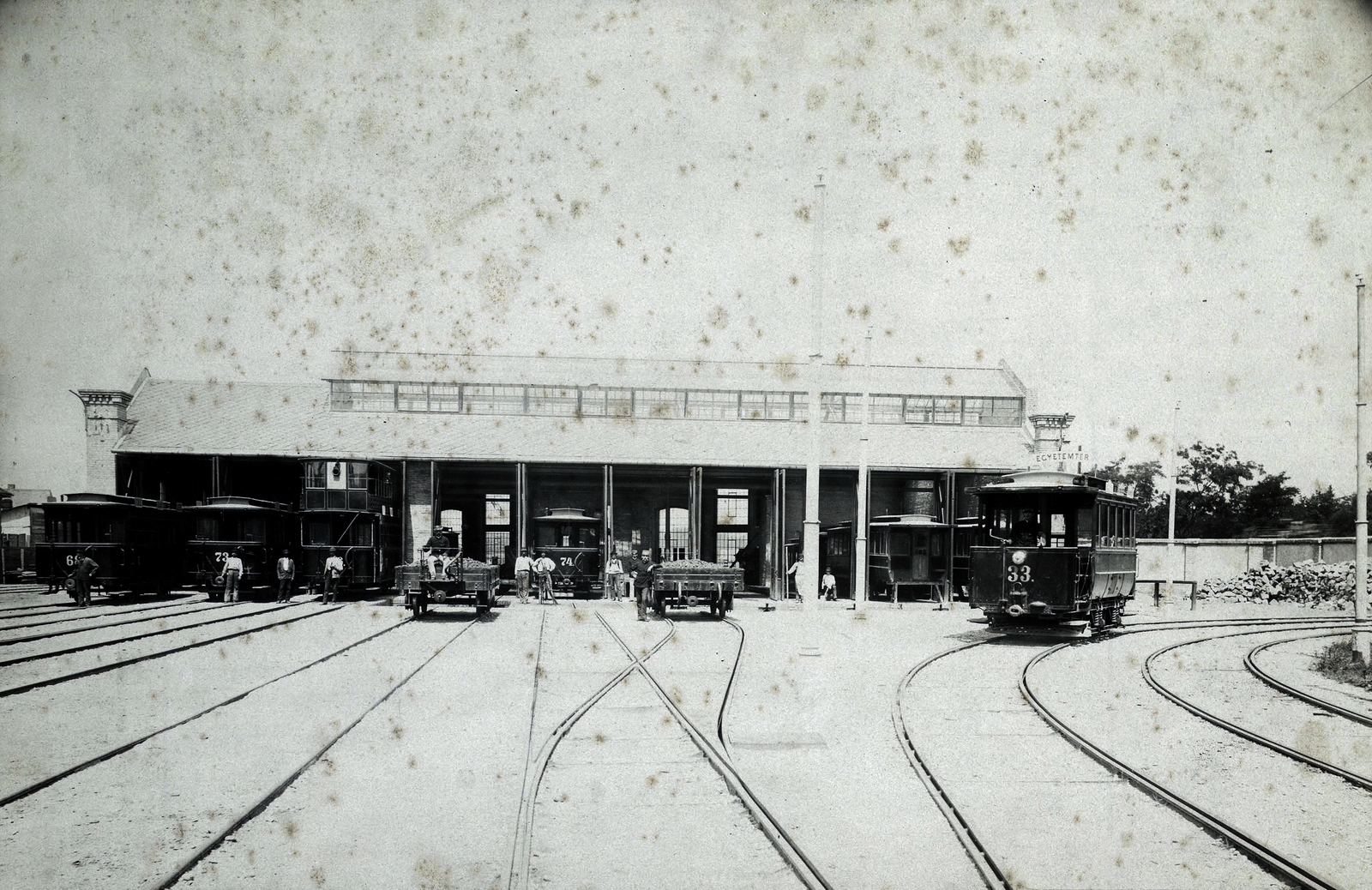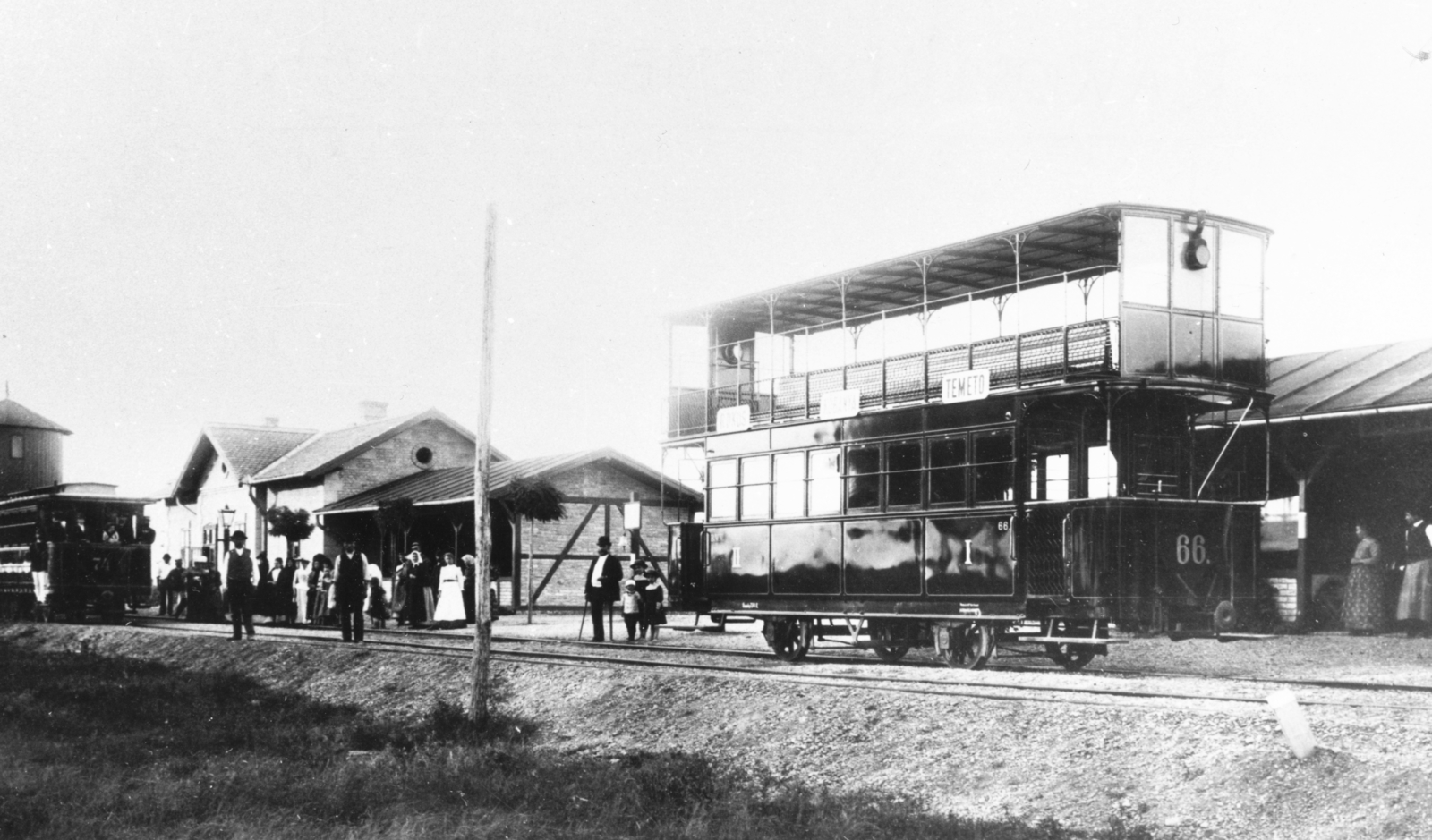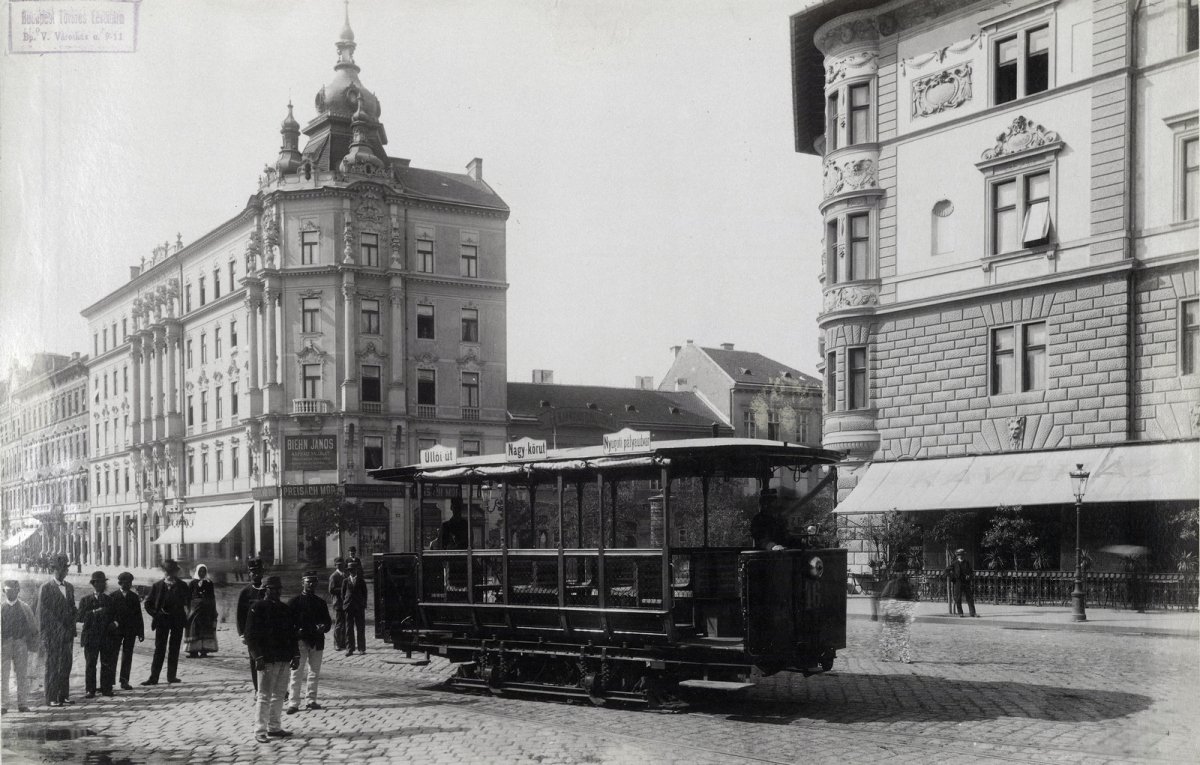In Budapest, on 28 November 1887, the vehicle was not pulled by horses or steam locomotives but moved by electricity, which was completely unusual at the time. Although the first electrically driven vehicle was created 32 years earlier by Ányos Jedlik, it was a tiny structure, not much bigger than a modern RC model. For electricity to actually move passenger vehicles, decades of development were needed, in which the work of Werner von Siemens was a pioneer.
.jpg)
The first test trams in front of Nyugati (Western) Railway Station (Photo: Fortepan/No.: 24111)
The tram with pantograph was presented by Werner von Siemens at an exhibition in Berlin in 1879, at the same time as a Russian inventor, Fyodor Apollonovich Pirocki, who created his invention in Saint Petersburg, but it was not a success in the then tsarist capital. Siemens knew about the experiment because his younger brother, Carl Siemens, was working in Saint Petersburg.
From 1881, the Siemens structure connected the Lichterfelde station and the military academy 2.5 kilometres away in Berlin; it ran in the suburbs because the Berlin city leaders were so distrustful of the system at first that they only allowed its use there.
The first European inner-city tram line was actually delivered a few years later, in Budapest, although it was only an experiment at the time, the vehicles were already carrying passengers. This system was also supplied by Siemens & Halske, and the appearance of the tram in Budapest was actually made possible by a patent dispute.
In Budapest, the BKVT, the company that operated the horse railways, had the privilege of the horse railway network. The privately-owned company and the capital's management had a dispute over where the network should develop, since the company wanted to expand it according to its own business considerations, while the city administration was following the city's interests, and these two interests often did not coincide. The city was powerless since BKVT had entered into the horse railway business with a contract.

Tram depot in Budapest in 1896 (Photo: Fortepan/Budapest Archives, Reference No.: HU.BFL.XV.19.d.1.01.030)
An engineer, Mór Balázs, who wanted to be the first to create a steam-powered urban railway network, brought a new point of view into this debate and discussed this with the leadership of Budapest. The city was inclined to do so, as this would have bypassed the BKVT. The plans changed from steam to electric when Mór Balázs managed to win Siemens as a partner, with whom he had a good personal relationship, and thus proposed the introduction of electric traction by Siemens & Halske.
Since such a structure had never operated anywhere within the city, the city first requested the construction of a test track, for which the section from the Nyugati Railway Station to Király Street was designated. The permission to build the line was granted on 1 October 1887, and thus Mór Balázs and his company were able to prepare the first test track. It still had a gauge of 1,000 millimetres, and the authorities set the speed of the tram at 10 kilometres per hour, but a policeman on horseback had to escort the tram through at the Andrássy Avenue intersection.
The tram had a unique feature, because the previous foreign vehicles received electricity from an overhead wire, using a pantograph. In the Budapest test, however, it received its energy from an underground line, via a pantograph hanging from the bottom of the car so the system operated in an underwired system because the Public Works Council did not allow the construction of overhead wires.
On 25 November 1887, Pesti Hírlap wrote the following about the tram's official inspection, when only representatives of the official bodies inspected the vehicle:
"First, two carriages started. One was connected to the electrical wire underground, the other car was just connected to the first one. One carriage can accommodate 22 passengers. The driver rang the bell, released the brakes, and the train started and headed towards Király Street, surrounded by the cheers of a large audience. On a normal route, it takes 3 minutes to travel the line, the trams travel at a speed of 10 kilometres per hour, taking into account the heavy traffic that occurs on some crossing streets of the boulevard and mainly on the Avenue. Then they connected 3 carriages; the committee held many trial runs, the tram was stopped several times suddenly and slowly, then one carriage was disconnected in the middle of the journey and went back, while the other two continued their journey. The trial sessions made a very favourable impression on the committee members. The carriage of the tram does not rattle, it can be easily stopped at any time, the train can be accelerated or decelerated as desired, all this can be done with the car brake."
The green-coloured, winterised, stove-heated cars were brought by Siemens from Vienna, as he had previously presented them there, and the first tram left on Monday, 28 November 1887, at half past two in the afternoon. The tram stopped at Andrássy Avenue and, as needed, at Szondi Street. The electricity was generated by two portable steam engines, which were placed in a barn next to the Nyugati Railway Station.

Double-decker tram, BVV tram at the New Public Cemetery between 1891–1893 (Photo: Fortepan/No.: 24113)
The pilot project was successful, there were no major accidents, only once, with a milk truck, did the tram crash. The technical problems that arose were mostly with the power-generating steam engines, and thus the tram eventually became a great success, even the sceptics were convinced by the new means of transport. Mór Balázs thus founded a company called the Budapest City Railway, and in 1889 the first regular tram was able to run. Today, everyone can see how trams and electric transportation have developed in Budapest.
Cover photo: The tram in regular traffic (Photo: Fortepan/Budapest Archives, Reference No.: HU.BFL.XV.19.d.1.07.109)








Hozzászólások
Log in or register to comment!
Login Registration